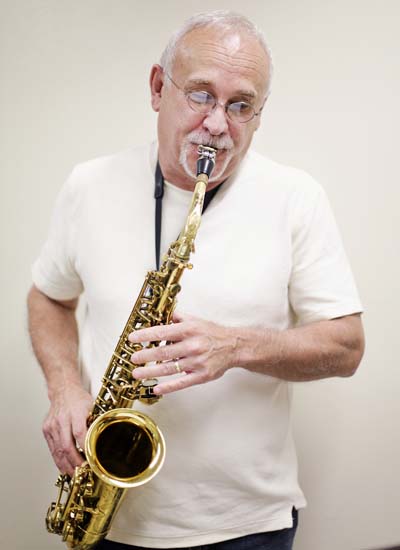Sax as new pitch of voice

Saxophone Professor Doug Masek will perform tonight at Schoenberg Hall alongside professors Juliana Gondek and Rakefet Hak. The trio founded an unconventional blend of piano, vocals and saxophone.
By Katie Meschke
April 13, 2010 9:24 p.m.
When asked to picture a singer performing with a saxophone player, chances are an image of some smoky old jazz club will come to mind. However, for a group of UCLA music professors, that image is only one of many styles that can come from combining sax with voice. From opera to cabaret, the chamber group unites classical and jazz saxophonists, vocalists, pianists and other players in a concert showing just how versatile voice and sax pairings can be.
The concert will feature saxophone Professor Doug Masek, voice Professor Juliana Gondek, opera Professor and pianist Rakefet Hak as well as a few of Masek and Gondek’s students.
Started by Masek and Gondek as an attempt to showcase the little-heard combination of saxophone and voice, the pair had worked on pieces together before and decided it was a good idea to expand their ideas.
“Pieces were written for me and written for (Gondek), but it was always like a one-shot deal. So this time we just got our heads together and thought it would be kind of fun just to do an entire program together,” Masek said.
Because of the relatively infrequent combination, however, obtaining music to perform presented a challenge. Instead of only selecting from songs that were already available, they asked UCLA faculty and composers around Los Angeles to create pieces for the concert.
“The classical saxophone is fairly rare, so we don’t have a lot of great quality pieces, … and a lot of times composers think the saxophone is too loud to be with a singer unless the singer is amplified or something extraordinary is done, so I think a lot of composers stay away from (the saxophone and voice combination),” Masek said.
Despite the low representation of sax-vocal works, the two musical entities share similarities. Australian composer Percy Grainger is even known to have stated that the saxophone is the instrument that comes closest to sounding like the human voice.
“(Masek’s) tone is so beautiful that it really is like a singing voice, so I really look upon our work together as two voices,” Gondek said. “He’s really able to adjust his sound to reflect whatever I’m doing vocally … it’s not as odd as one might think right off the bat.”
Gondek said singing with the saxophone allows for much more vocal freedom as the two play off each other.
“This concert calls on me to produce a wide variety of vocal sounds, not just my normal classically produced operatic sound. Various pieces in this program call on me to produce a jazz sound, a blues sound … at one point I turn into a bubblegum teenybopper rock ‘n’ roll singer, so it’s fun for me to be able to put on all these different voices,” Gondek said.
The duo will be backed by various instruments throughout the concert, including piano.
“When I was asked to play in this recital, I was thinking to myself, “˜Wow, what an odd and interesting combination,'” said Hak, who will be playing piano during the more classical numbers. “Piano fits in with all different combinations because the piano is a very versatile instrument … the saxophone is an instrument that I’ve never performed with, so it’s definitely refreshing, and it’s something new.”
The concert also brings in some of the world’s most talented jazz musicians, including Abraham Laboriel Sr., the most recorded jazz bass player in history. Laboriel has performed with the likes of Stevie Wonder, Madonna and Herbie Hancock.
“What we’re trying to do is marry together our classical backgrounds. (Masek) is a classically trained saxophonist … though he’s famed as a jazz sax player as well,” Gondek said. “Abe (Laboriel), while being a rock ‘n’ roll and jazz bass player, also is a highly trained, highly skilled musician, who can sight read anything that’s put in front of him. You give him a classical piece of music, and he can play it. We have a very carefully chosen group of collaborators, who are able to play all across the lines.”
Not only does the performance allow students to see their professors in action, it also has allowed the professors themselves to work with other members of the department.
“My favorite part is working with the great colleagues I have. These are just great musicians, so to me it’s just getting up there and playing with star performers and playing great music,” Masek said. “I couldn’t ask for anything else.”


